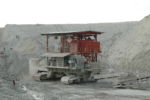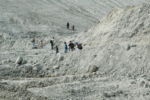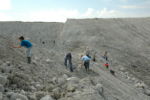Holiday program in the quarry
On the 19th of July 2003 we went on an excursion in the framework of the holiday program of the city of Bremen. We were heading for the Höver quarry near Sehnde, close to Hannover in Lower Saxony in Northern Germany. The aim of this activity was to give children and young people the possibility to collect, prepare and determine fossils.
.
Preparation and determination took place in the Geosciences Collection during the two weekends following the excursion. We were co-operating with the Kreissportbund Bremen (a joinder of sports club in the Bremen area) and the Marum. More people where asking to register then we had space. Fortunately there were many volunteers helping. The experienced fossil collectors Ludwig Kopp, Jürgen Reinhard and Peter Jörres of the Geowissenschaftlichen Arbeitskreis helped to make the excursion day a success.
Specimens
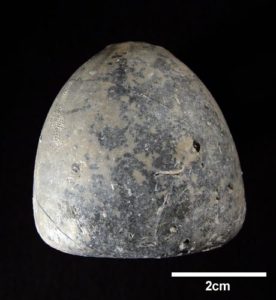 Mr. Scharnhorst of the Holcim company showed us the collection owned by the company in the entrance hall of the cement company. Afterwards we went into the quarry and he gave tips on where to find the most fossils. The “primeval times researcher” quickly had success. First findings included devils fingers, the fossil internal skeletons of extinct squids, the belemnites. Only minutes later sea-urchins were also found that belong to the most common fossil groups in Hannover. The children found the hemisphaerical Echinocorys and tests of the comparatively more rare Micraster. The outline of the latter lead to the general term heart sea-urchin. One of the young persons even found a spine of the rare regular sea-urchins. The happiness about this specimen
Mr. Scharnhorst of the Holcim company showed us the collection owned by the company in the entrance hall of the cement company. Afterwards we went into the quarry and he gave tips on where to find the most fossils. The “primeval times researcher” quickly had success. First findings included devils fingers, the fossil internal skeletons of extinct squids, the belemnites. Only minutes later sea-urchins were also found that belong to the most common fossil groups in Hannover. The children found the hemisphaerical Echinocorys and tests of the comparatively more rare Micraster. The outline of the latter lead to the general term heart sea-urchin. One of the young persons even found a spine of the rare regular sea-urchins. The happiness about this specimen 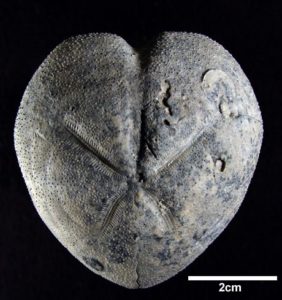 did not last long since it was lost later on. However, most children did not care about failures like that, but rather were digging to near the point of exhaustion. Some of the sea-urchins were not filled with calcareous mud millions of years ago. This produced cavities that were filled with minerals like coelestin or calcite after a significant amount of time. Broken sea-urchins therefore show a shiny little world of crystals. Ammonites were collected as well, for example a specimen of the genus Pachydiscus. A specimen of the same genus was also found stuck in the wall of the quarry, but we decided to leave it where it was for safety reasons. Even vertebrate fossils were found. The scales of bony fishes were one discovery the other a fragmentary shark tooth found by an accompanying father.
did not last long since it was lost later on. However, most children did not care about failures like that, but rather were digging to near the point of exhaustion. Some of the sea-urchins were not filled with calcareous mud millions of years ago. This produced cavities that were filled with minerals like coelestin or calcite after a significant amount of time. Broken sea-urchins therefore show a shiny little world of crystals. Ammonites were collected as well, for example a specimen of the genus Pachydiscus. A specimen of the same genus was also found stuck in the wall of the quarry, but we decided to leave it where it was for safety reasons. Even vertebrate fossils were found. The scales of bony fishes were one discovery the other a fragmentary shark tooth found by an accompanying father.

Finest weather for “young researchers”
Under a clear blue sky fossil collecting started in the quarry estate. The weather was excellent on this sunny and hot summer’s day. It was even too hot and additionally the sun rays were reflected by the light quarry walls. This lead into temptation to seek out the shadow at the base of the quarry wall. However, even without wind and wearing a hard hat, this is too dangerous. Anyway, there was plenty of drinking water in the bright sun and additionally our “Service Point” including a sunshade provided help for exhausted “young researchers”. Besides drinks and tools as well as working gloves the “Service Point” was also providing first aid and additional information about fossils and the Hannover quarry.

Limestone built of small organisms
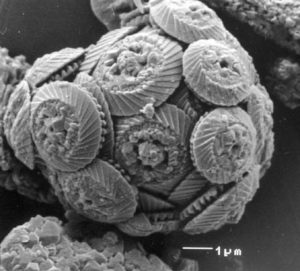 The rock was formerly calcareous mud built in a warm and shallow sea that covered most parts of Germany in those days. The mud consists of the remains of millions of skeletons of unicellular animals and plants. In particularly the accumulation of calcareous bodies of the microscopically small coccolithophorids and the calcareous tests of foraminifers (chambered microorganisms) are responsible in building up these deposits. Coccolithophorids are a group of basal algae and foraminifers are unicellular animals. Besides these microorganisms, also called microfossils, the rock is built up of small particles of the destructed shells of larger animals, like mussels and sea-urchins. This experience was also made by the children and young persons of our holiday program that found many complete but even more incomplete specimens and a lot of small fragments.
The rock was formerly calcareous mud built in a warm and shallow sea that covered most parts of Germany in those days. The mud consists of the remains of millions of skeletons of unicellular animals and plants. In particularly the accumulation of calcareous bodies of the microscopically small coccolithophorids and the calcareous tests of foraminifers (chambered microorganisms) are responsible in building up these deposits. Coccolithophorids are a group of basal algae and foraminifers are unicellular animals. Besides these microorganisms, also called microfossils, the rock is built up of small particles of the destructed shells of larger animals, like mussels and sea-urchins. This experience was also made by the children and young persons of our holiday program that found many complete but even more incomplete specimens and a lot of small fragments.
Geological age
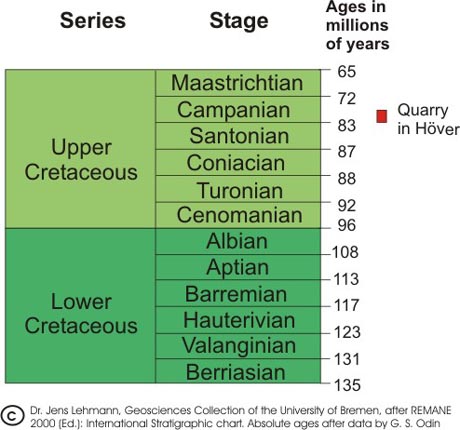 The lime- and marlstones of the Hannover area are a part of the Upper Cretaceous, a time span of the Earth’s history that began 100 million years ago and ended about 65 million years ago – when dinosaurs became extinct. The Höver quarry belongs to the Campanian stage of the Upper Cretaceous, consequently the rocks are about 80 million years old. The sea-floor was uplifted by salt domes deep in the ground and the formerly horizontal plan was tilted. Many faults shattered the rock. A careful observation of the quarry walls show the oblique bedding plane of the rock as well as faults dividing the succession into single packages – often directed almost perpendicular to the bedding plane. This is the reason why the whole section that is about 100 m in thickness, deposited over a time span of about 3 million years, is not exposed in one single piece.
The lime- and marlstones of the Hannover area are a part of the Upper Cretaceous, a time span of the Earth’s history that began 100 million years ago and ended about 65 million years ago – when dinosaurs became extinct. The Höver quarry belongs to the Campanian stage of the Upper Cretaceous, consequently the rocks are about 80 million years old. The sea-floor was uplifted by salt domes deep in the ground and the formerly horizontal plan was tilted. Many faults shattered the rock. A careful observation of the quarry walls show the oblique bedding plane of the rock as well as faults dividing the succession into single packages – often directed almost perpendicular to the bedding plane. This is the reason why the whole section that is about 100 m in thickness, deposited over a time span of about 3 million years, is not exposed in one single piece.
Quarrying limestone and production of cement
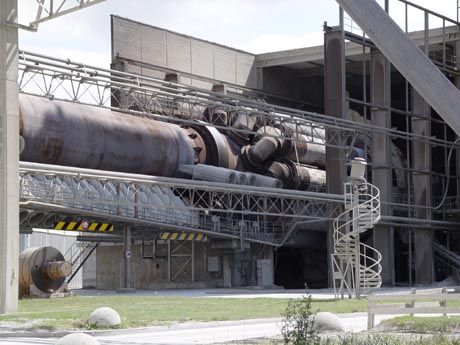 The Höver quarry visited is owned by the Holcim company, formerly known as Alsen AG. At this site lime- and marlstone for the production of cement has been quarried since 1907 – up to a depth of 50 m. The limestone is a mixture of calcium carbonate and clay minerals. The content of clay and chlorite varies within the single beds, but since a homogenous value is important rock is quarried at different locations in the quarry and mixed later. After destructing the rock in the quarry the grain size is smaller than 10 cm. The material is then transported by a conveyor belt for more than 2 km to the company buildings. There it is grinded down and burnt in huge rotating ovens. Old car tires and yellow bags from Germany’s recycling system are added during the process of burning. A highly sophisticated filter system ensures that the environment is not polluted by poisonous matter. However, the production of cement was not the topic of the Bremen holiday program. The picture originates from a visit to the company buildings during the Bremen Summer University in July 2003.
The Höver quarry visited is owned by the Holcim company, formerly known as Alsen AG. At this site lime- and marlstone for the production of cement has been quarried since 1907 – up to a depth of 50 m. The limestone is a mixture of calcium carbonate and clay minerals. The content of clay and chlorite varies within the single beds, but since a homogenous value is important rock is quarried at different locations in the quarry and mixed later. After destructing the rock in the quarry the grain size is smaller than 10 cm. The material is then transported by a conveyor belt for more than 2 km to the company buildings. There it is grinded down and burnt in huge rotating ovens. Old car tires and yellow bags from Germany’s recycling system are added during the process of burning. A highly sophisticated filter system ensures that the environment is not polluted by poisonous matter. However, the production of cement was not the topic of the Bremen holiday program. The picture originates from a visit to the company buildings during the Bremen Summer University in July 2003.
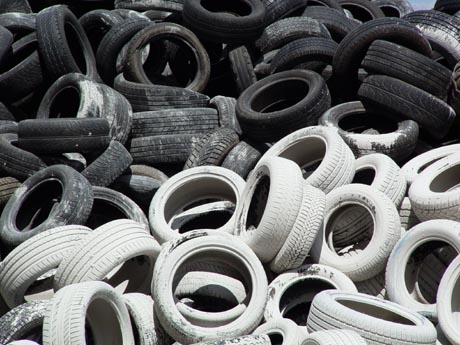
Preparation of Höver fossils
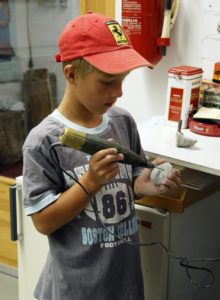 Just collecting fossils does not make a researcher and therefore the young palaeontologists and consequently two more days, the 26th of July and the 2nd of August 2003, were added to our program to deal with the collected material in the Geosciences Collection. The limestone respectively the limy marlstone of Höver is easy to process. The preparation of fossils began with cleaning the raw material. Washing and brushing dissolved the sticky marlstone mud. Rock remains were chipped off by hammer and chisels as well as small steel needles and scrapers. What a sophisticated final preparation looks like was shown by the preparatory Martin Krogmann in the laboratory of the Geosciences Collection. Belemnites can be prepared by air-driven chisels out of the rock, this also works well for larger remains of matrix on sea-urchins. In addition the latter may often show lime encrusted surfaces that can be removed by air-brassive tools with almost no damage.
Just collecting fossils does not make a researcher and therefore the young palaeontologists and consequently two more days, the 26th of July and the 2nd of August 2003, were added to our program to deal with the collected material in the Geosciences Collection. The limestone respectively the limy marlstone of Höver is easy to process. The preparation of fossils began with cleaning the raw material. Washing and brushing dissolved the sticky marlstone mud. Rock remains were chipped off by hammer and chisels as well as small steel needles and scrapers. What a sophisticated final preparation looks like was shown by the preparatory Martin Krogmann in the laboratory of the Geosciences Collection. Belemnites can be prepared by air-driven chisels out of the rock, this also works well for larger remains of matrix on sea-urchins. In addition the latter may often show lime encrusted surfaces that can be removed by air-brassive tools with almost no damage.
Fossils as living organisms
The scientific approach to fossils was demonstrated by Prof. Dr. Jens Lehmann for example by analysing the tests of sea-urchins. Questions like the following were the focus of the interest: Where did the spines of the fossil sea-urchin disappear to? Why are sea-urchins bilateral-symmetrically – like also human beings are for example? What are the flat discs, tubes, holes and grooves on the tests of sea-urchins? A picture has been developed of sea-urchins that are living in the mud of the sea-floor. The sea-urchins move through the soft mud and live by feeding upon the mud but using only the nutrients. Occassionally the sea-urchins were attacked by other animals, e.g. fishes that crack the tests of sea-urchins. After predation or after its natural death the tiny spines of the sea-urchins of Hannover quickly loose contact with the calcareous test and are destroyed. The tests make it possible for many animals to settle on the firm ground of a sea-urchin test that would not survive on the soft calcareous mud of the sea-floor itself. This includes worms with calcareous tubes, small oysters and corals. Some of the empty tests of sea-urchins are also bored by the sponge Clionia, as is interpreted from round holes.
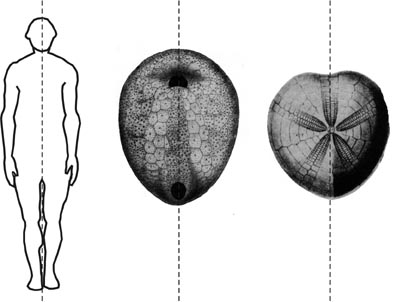
Further information
Fossils of the Höver pit are housed in the Geosciences Collection, but these are only accessible to the public by guided tours, special exhibitions and courses. People who would like to see fossils from the Campanian of Hannover should visit the Niedersächsische Landesmuseum in Hannover at lake Maschsee, where huge ammonites and other nice specimens are on display from the Höver quarry. Those who want to know more about the locality and its fossils should additionally refer to the following selection of papers, that focus on the Hannover region and especially on the Höver quarry and its fossils. Generally comprehensive and general references are marked by an (A) at the end of the citation.
-
- Ernst, G. (1972): Grundfragen der Stammesgeschichte bei irregulären Echiniden der nordwesteuropäischen Oberkreide. – Geologisches Jahrbuch 4: 63-175.
- Ernst, G. (1975): Stratigraphie, Fauna und Sedimentologie der Oberkreide von Misburg und Höver bei Hannover (Exkursionsführer). – Mitteilungen aus dem Geologisch-Paläontologischen Institut der Universität Hamburg 44: 69-97.
- Frerichs, U. (1989): Die Micraster aus dem Campan von Misburg und Höver.- Arbeits-Kreis Paläontologie Hannover 17: 151-167.
- Frerichs, U. (1989): Erdöl in einem Seeigel aus Höver. – Arbeits-Kreis Paläontologie Hannover 18: 138-139.
- Frerichs, U. (1994): Betrachtungen zu Coeloptychium aus dem Campan von Hannover. – Arbeits-Kreis Paläontologie Hannover 22: 1-20.
- Frerichs, U. (1994): Elasmosaurus sp. aus dem Untercampan von Höver – eine Funddokumentation. – Arbeits-Kreis Paläontologie Hannover 22: 33-42.
- Frerichs, U. (1995): Die kleinen irregulären Seeigel aus dem Untercampan von Höver und Miesburg. – Arbeits-Kreis Paläontologie Hannover 23: 1-19.
- Frerichs, U. & Frerichs, K. (1978): Ein Saurierfund aus der Oberkreide von Höver. -Arbeits-Kreis Paläontologie Hannover 6: 12-16.
- Frerichs , U. (Hrsg., 2005): Fossilien aus dem Campan von Hannover. – Arbeitskreis Paläontologie Hannover, Schäfer Druckerei, Hannover: 94. (A)
- Helm, C. (1997): Seesterne (Asteroidea) aus dem Campan von Hannover (Misburg, Höver). – Arbeits-Kreis Paläontologie Hannover 25: 93-119.
- Helm, C. (1998): “Knopfkorallen” aus Mitteleuropa und ihre Lebensweise. – Arbeits-Kreis Paläontologie Hannover 26: 33-46.
- Helm, C. (1999): Onchotrochus minimus (Bölsche) – eine scolecoide, an Weichböden angepasste Koralle (boreale Oberkreide). – Mitteilungen aus dem Geologisch-Paläontologischen Institut der Universität Hamburg 83: 191-202.
- Helm, C., Jagt, J. W. M. & Kutscher, M. (1999): Early Campanian ophiuroids from the Hannover area (Lower Saxony, Northern Germany). – Berliner Geowissenschaftliche Abhandlungen 30: 161-173.
- Hungerbühler, A. (1992): Fossilien: Versteinerungen von Tieren und Pflanzen. Stuttgart, Kosmos (Franckh-Kosmos): 97. (A)
- Jagt, J. W. M. (1988): Boletechinus (Echinoides, Zeuglopleuridae) im Untercampan von Hannover. – Arbeits-Kreis Paläontologie Hannover 16: 14-16.
- König, W. (1990): Brachiopoden aus dem Campan von Höver und Misburg.” Arbeits-Kreis Paläontologie Hannover 18: 118-121.
- König, W. (1990): Muscheln aus dem Campan von Höver und Misburg. – Arbeits-Kreis Paläontologie Hannover 18: 49-55.
- König, W. (1991): Die Schwämme des Campans von Misburg und Höver. – Aufschluss 42: 65-82.
- König, W. (1991): Die Schwämme des Campans von Misburg und Höver, III. Teil. – Arbeits-Kreis Paläontologie Hannover 22: 21-23.
- König, W. (1991): Octokorallen-Basen aus dem Campanium von Misburg und Höver. – Arbeits-Kreis Paläontologie Hannover 19(6): 153-176.
- Krüger, F. J. (1980): Die Kreidegrube Höver, ein Fenster zum Untercampan. – Mineralien-Magazin 4: 198-204. (A)
- Krüger, F. J. (1983): Geologie und Paläontologie: Niedersachsen zwischen Harz und Heide. – Kosmos, Stuttgart: 244. (A)
- Krüger, F. J. (1995): Leere oberkretazische Echiniden-Coronen als Habitat benthonischer Organismen. – Berliner Geowissenschaftliche Abhandlungen 16: 79-89.
- Krüger, F. J. (1995): Zwangshabitate von Mollusken in leeren Seeigel-Coronen aus dem Campan von Höver und Misburg. – Arbeits-Kreis Paläontologie Hannover 23: 31-40.
- Krüger, F. J. (2001): Das Campan von Höver. – In Weidert, W.-K. (Hrsg.): Klassische Fundstellen der Paläontologie – Band IV. Korb, Goldschneck-Verlag: 152-164. (A)
- Mutterlose, J., Wood, C. J. & Ernst, G. (1998): The Lower and Upper Cretaceous of the Hannover-Braunschweig area (NW-Germany). C 1. Introduction. – In Mutterlose, J.; Bornemann, A.; Rauer, S.; Spaeth, C. & Wood, C. J. (Hrsg.): Key localities of the northwest European Cretaceous. – Bochumer Geologische und Geotechnische Arbeiten 48: 39-51.
- Schormann, J. (1988): Schnecken aus dem Campan von Hannover. – Arbeits-Kreis Paläontologie Hannover 16: 84-92.
- Schormann, J. & Zawischda, D. (1990): Sekundäre Hartböden – fossil überliefert. – Arbeits-Kreis Paläontologie Hannover 18: 20-23.
- Stanley, S. M. (1994): Historische Geologie. Eine Einführung in die Geschichte der Erde und des Lebens. – Spektrum Akademischer Verlag, Heidelberg: 636. (A)
- Stratigraphische Kommission Deutschland (Hrsg., 2000): Die Kreide der Bundesrepublik Deutschland. – Courier Forschungsinstitut Senckenberg. Frankfurt 226: 207.

